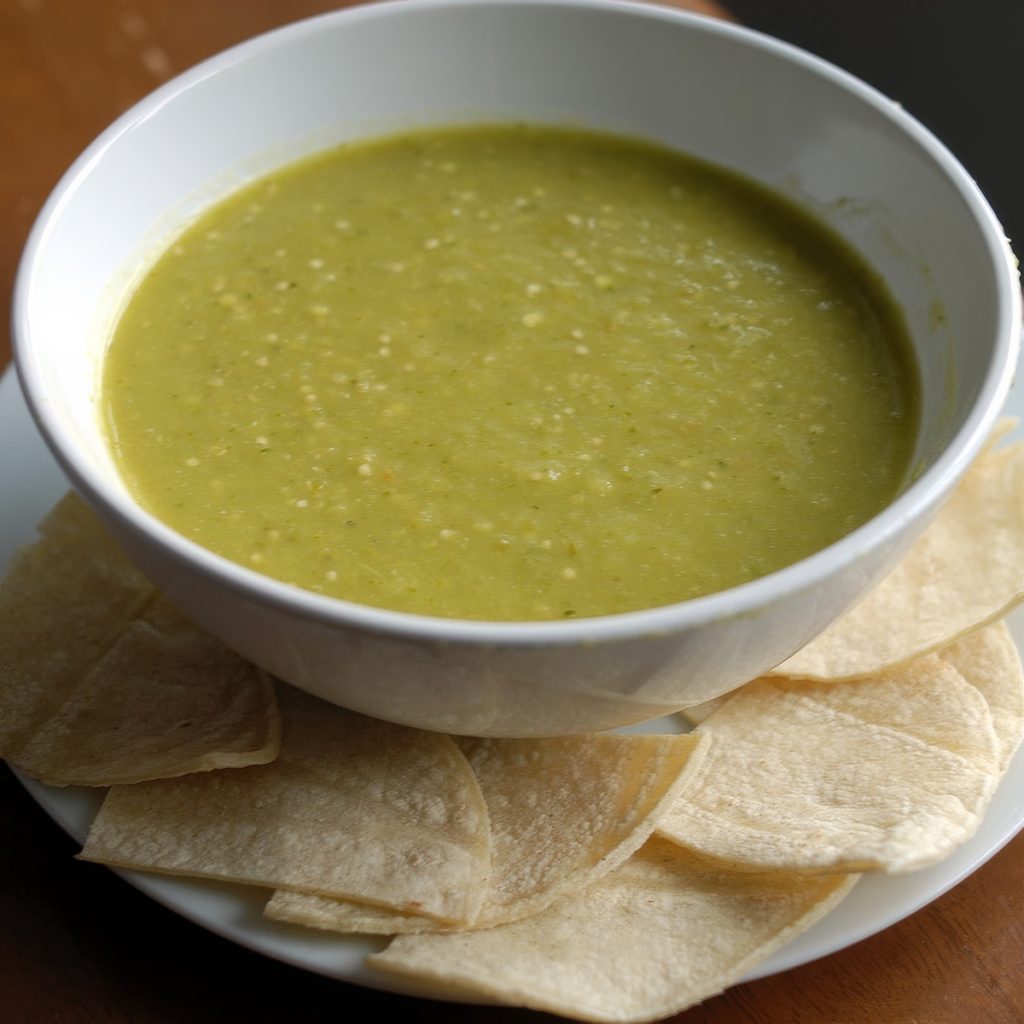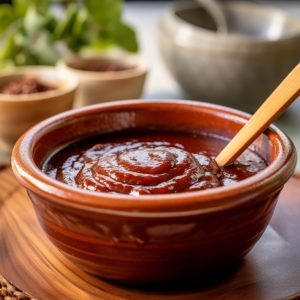Tomatillo Salsa
When I think of salsa, I think of fresh tomatoes with chunks of red tomato and bell peppers. Salsa is Spanish for “sauce,” so there are many different types of salsa to enjoy. Recently, I showed you how I prepared a Chipotle salsa, and now I want to teach you how to make tomatillo salsa, as my Mexican friend Paula taught me.
Tomatillo salsa, also known as salsa verde, is a vibrant and zesty staple of Mexican cuisine that can transform a meal from ordinary to extraordinary. Made from the tart and tangy tomatillo, this salsa offers a fresh, slightly acidic flavor profile that pairs beautifully with various dishes. Whether you’re drizzling it over tacos, using it as a dip for tortilla chips, or adding a burst of flavor to grilled meats and vegetables, tomatillo salsa is incredibly versatile.
The heart of this salsa is the tomatillo, a green fruit enclosed in a papery husk. This fruit adds a unique tanginess that differentiates it from traditional red tomato salsas. When combined with fresh cilantro, spicy jalapeños, pungent garlic, and a squeeze of lime juice, the tomatillos create a symphony of refreshing and invigorating flavors. Roasting the tomatillos and other ingredients enhances their natural sweetness and adds a subtle smokiness, elevating the overall taste.
Perfect for any occasion, from casual family dinners to festive gatherings, this tomatillo salsa recipe is easy to make and sure to impress. Embrace the authentic flavors of Mexico and enjoy the burst of freshness that this homemade tomatillo salsa brings to your table.
History
Tomatillo salsa, commonly called salsa verde, has deep roots in Mexican culinary tradition, dating back to pre-Columbian times. The tomatillo, also known as the Mexican husk tomato, was cultivated by the Aztecs and other Mesoamerican civilizations over 2,000 years ago. These ancient cultures recognized the tomatillo’s unique flavor and nutritional benefits, incorporating it into various dishes.
The name “tomatillo” derives from the Nahuatl word “tomatl,” which is also the origin of the word “tomato.” However, despite the similarity in their names, tomatillos and tomatoes are distinct fruits. Tomatillos are encased in a papery husk and possess a tart, slightly acidic taste, setting them apart from the sweeter, juicier tomato.
Salsa verde was traditionally made by grinding roasted or boiled tomatillos with a molcajete (a traditional stone mortar and pestle), combining them with chiles, garlic, cilantro, and other local ingredients. This preparation method has been passed down through generations, preserving the authentic flavors and textures of the salsa.
Over time, salsa verde has become a staple in Mexican cuisine, enjoyed both in homes and on festive occasions. It is celebrated for its versatility, which is capable of enhancing a wide variety of dishes from tacos and enchiladas to grilled meats and seafood. The enduring popularity of tomatillo salsa speaks to its rich cultural heritage and its enduring appeal as a fresh, flavorful condiment.

What Are Tomatillos?
Sometimes called green tomatoes or husk tomatoes, tomatillos are fruit about the size of a ping-pong ball with an inedible, paper-like husk surrounding it. When ripe, they can be yellow, purple, or even red, but you will most often find green ones.
When buying tomatillos, look for intact, light-brown husks. If the husk is dry and shriveled, the fruit may not be in very good condition. Make sure the tomatillo is firm and free of blemishes. If you can’t find them fresh, you may be able to find them canned in your local market, but they are not the same.
Tomatillos have a tart flavor and are a staple in Mexican cooking. Paula says this tomatillo salsa is popular in Mexico because tomatillos are so available and inexpensive. She told me they were so plentiful in the town she grew up in you could walk down the road and find them growing wild.
Although the first domesticated tomato, which we are familiar with, may have first been grown by the Aztecs of Central Mexico, red tomatoes are often too expensive for many Mexicans to use for their salsas. Therefore, tomatillos are a good substitute and are very popular in sauces (salsas).
Don’t confuse a tomatillo with the green tomato made famous in the 1991 film Fried Green Tomatoes. They are not the same. Although they are in the same family, nightshade, they are a different genus.
Sauce or Salsa
Yes, I know they mean the same thing, but how you use this sauce determines how much water you use. Paula uses tomatillo sauce, like most of us, for additional flavor in chicken, pork, and fish dishes. She may use it inside a fajita or to cook enchiladas.
What I am saying is that she pours it on, over, or into whatever she is serving it with, which makes it very liquid. If you want to use this as a more traditional salsa to serve with chips, use half the water for a thicker result.
How Hot Do You Want It?
This gets confusing because the first time we made this, Paula used 6 jalapeños. The next time, we used only 2, and it was even spicier. When asked, she said it depends on the jalapeños’s age. Older jalapeño peppers are hotter than young ones. See my post on jalapeños peppers. So, for this recipe, I will say 2 to 6 jalapeños depending on how hot you like it and how hot the jalapeños are.




Tomatillo Sauce (Salsa) Recipe
Ingredients
- 1 pound fresh tomatillos husks removed
- 4 jalapeno peppers see above
- 2 cloves garlic
- 1 - 2 cups of water - depending on how thick you like it
- 3 sprigs fresh cilantro
Instructions
- Add the tomatillos, jalapenos, garlic cloves and water to a saucepan.
- Bring to a boil then lower heat just a bit and continue to simmer for 30 minutes.
- Transfer to a blender and puree until smooth.
- Add the cilantro and puree again.

















9 Responses
Joined Weight Watchers so I’m eating more veggies & fruits. I love mexican food so I can’t wait to try this on all kinds of things. I think I may try it on a poached egg this weekend. Will let you know 🙂
I also love to mix sour cream into tomatillo sauce along with some lime juice… great as a sauce or dip for meats and lots of other things, as well as just for nachos, etc.
(Also use regular salsa + bit of sour cream to perk up various things.)
Thanks for the recipe, and also the info on how to tell mild from hot jalapenos! Helpful.
Thx for the info re the peppers. Q: Can this be made with red tomatoes? I don’t recall ever seeing tomatillos in my country. Is the salsa tasty w/out added seasonings? Do u know a good substitute 4 cilantro? Thx.
Hi Spooscott, there are many salsa recipes out their where you can use red tomatoes but this isn’t one of them. I would make a fresh salsa with the red tomatoes but sure you can puree everything to make a sauce. You might want to substitute parsley for the cilantro but the results will be completely different but still good.
What country is that may I ask? I would personally recommend using green tomatoes to replace the tomatillos as opposed to a red tomato. The flavor profile will be much closer. Cilantro is key ingredient in there’s nothing like it. If people do not like cilantro they often use flat leaf parsley. Another thought oh, do you have coriander Where You Are? If you do, you could use parsley and coriander mixed together. Of course these are just my opinions. I would consider using an asset of some kind like lime juice or some type of vinegar you can’t. Salt and pepper are pretty important too. I also would add some onion. LOL I know that’s changing everything but like a lot of flavor and that’s not being developed without acids or salt
Can you bottle this sauce and use it like a green tabasco?
Hi Sheila, I guess if you know how to make it shelf stable and add the right ingredients so it doesn’t have to be refrigerated but I find we go through it so fast, we make a fresh batch each week. It’s not like green Tabasco where you only add a few drops. I pour some onto leftover chicken and fish dishes or on top of omelets.
I also make a version of this sauce.
Honey will help offset any bitterness from the tomatillos, and lime juice will brighten it up. Also, most Mexicans use a lot more cilantro!
My ingredients: tomatillos, onion, serrano, garlic, cilantro, lime juice, honey, salt, pepper.
One very important aspect of tomatillos: you MUST rinse them. The sticky stuff is very bitter and can ruin a dish.
Agreed. What about angry added acid. Yes…they need to rinse them while rubbing thoroughly. ?